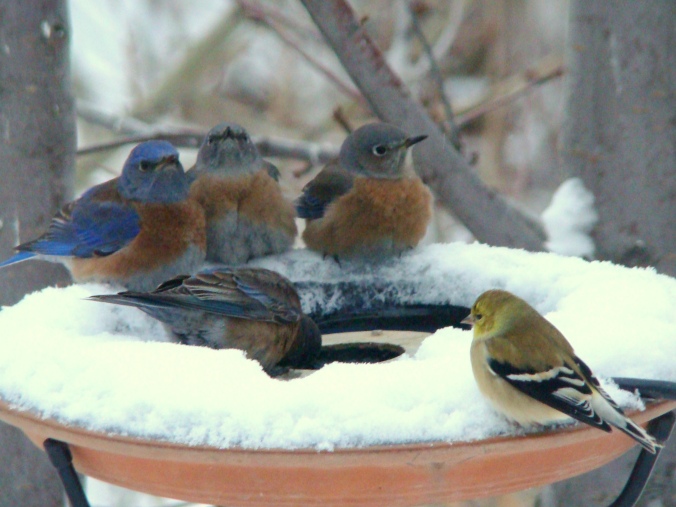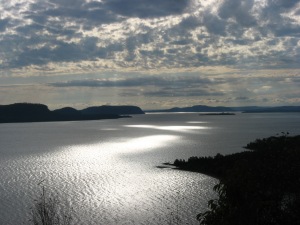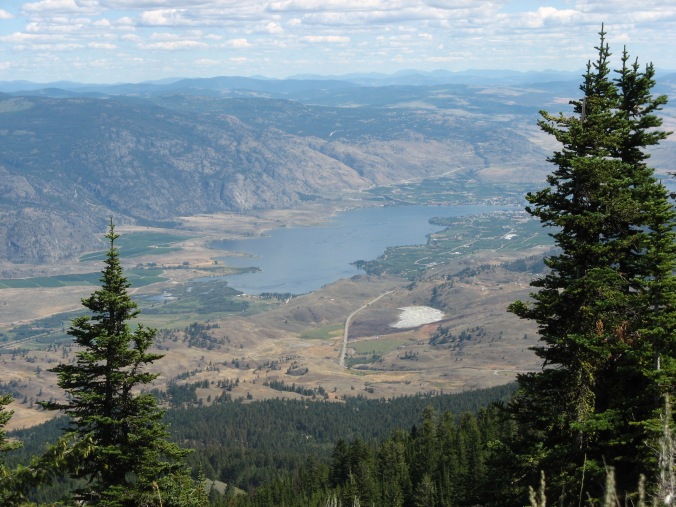Even though it’s still August, and the air is hot and humid, I’m sure I’m not the only one who has noticed that the days are getting shorter, the nights are getting longer, and some of the leaves have a distinct reddish tinge to them. We may prefer to pretend it’s not happening, but we all know it: fall is on the way. For millions of birds across North America, it’s time to start thinking about packing their bags and turning their sights to the south. As summer draws to a close and our forests and fields begin to empty out, I’d like to share a post about migration that I originally wrote for Land Lines, the Nature Conservancy of Canada’s blog, back in the spring – when all the birds were just returning.
“We’ve got rocks and trees, and trees and rocks, and rocks and trees, and trees and rocks, and…rocks and trees, and trees and rocks, and water…in Canada.”
-Arrogant Worms, “Rocks and Trees”
Ever since getting my driver’s licence, I’d dreamed of driving across Canada. As a concept, it seemed romantic and adventurous – the perfect way to really get to know my own country. But the reality, it turned out, was a bit different. As I set off from Sudbury on my second day of cross-country driving, I wanted to be excited. The first day had been easy: only six hours in the car, and a friend waiting for me at the other end. But today was the real start of the adventure. Today, I’d be leaving the relative safety of roads I knew well and passing into territory that was unknown, at least to me.
As I pointed my car west and hit the gas, I was more terrified than excited. Six thousand kilometers is a lot of road – especially when you’re driving alone. In an effort to kickstart my enthusiasm, I reached over to slide the “Canadiana” mix CD a friend had made for me into the car’s CD player. As the first strains of the Arrogant Worms’ “Rocks and Trees” came over the speakers, I glanced out the window and couldn’t help but laugh. A vast, lonely landscape met my gaze, composed of…well, rocks, trees, and water. Somehow, the song wasn’t actually making me feel any better.
The purpose of this epic journey was to get myself out to BC, and begin my PhD research on the population of western bluebirds that breeds in BC’s Okanagan Valley. Although there are bluebirds (of one species or another) across the country, I was particularly interested in this population because of their migratory behaviour: the western bluebirds in the Okanagan are partial migrants. This means that while some birds migrate south in the fall, others hang around the Okanagan, gather into flocks, and brave the snow and cold of a Canadian winter.

Western bluebirds (and one lone goldfinch) check out a heated bird bath on a cold winter day. Photo credit: Eva Durance.
I’ve been fascinated by avian migration ever since taking my first Animal Behaviour course as an undergraduate. This fascination has shaped the last eight years of my life, informing my research interests as a graduate student. Migration is a common phenomenon: every year, billions of individuals from more than 350 bird species across North America embark on migratory journeys. Migration is ubiquitous, and each spring and fall, as I hear the honks of Canada geese passing overhead, I’m tempted to call it ordinary. But this common phenomenon is composed of extraordinary feats. As summer winds down in the northern hemisphere, birds like the 25g northern wheatear set off into the unknown, often travelling thousands of kilometers south to spend the winter in more hospitable climates. In the case of the wheatear, individuals breeding in the Canadian Arctic and Alaska brave the perils of crossing the Atlantic, ultimately covering 14,000 km to reach their wintering grounds in sub-Saharan Africa. Then, come spring, they do it all over again in reverse.
Migration captures the imagination of scientists and the public alike. But what is it about these journeys that inspires and enchants us? That’s a question I’d never been able to answer satisfactorily, but as I faced the vast, lonely distances of my own incredible journey, the answer became clearer: migration may be common, but it is also an extraordinary story of adventure and challenge.
To begin with, you must decide when to leave. For birds, timing of migration is affected by many things – from predator abundance to food availability and individual condition – but it’s crucial that they get it right. This is especially true in the spring, when arriving too late on the breeding grounds can undermine the success of an individual’s breeding season. However, timing is also important in the fall, when staying too late can mean encounters with the kind of weather you’d rather avoid – as I found out the hard way.
Of course, once you’ve decided to leave, it’s also very important to know where you’re going. Unfortunately for me, I’m one of the most directionally challenged people imaginable. (Despite the fact that driving from Ontario to BC essentially involves following the Trans-Canada highway west, a number of people were actually placing bets on whether I’d end up in BC or Nova Scotia.) Luckily, I had help: before I embarked on my journey, my mother dragged me to the CAA to purchase a staggering number of maps. I ended up with a separate map for every Canadian province west of Quebec, a very long set of driving directions, and a North American road atlas for good measure. Despite this plethora of directional aids, I can’t deny making the occasional U-turn on quiet parts of the Trans-Canada.
Birds, of course, have to manage without the help of the CAA. Instead, they get their directional cues from a variety of sources: the sun, the stars, and the Earth’s magnetic field. Recent research also suggests that scent cues may play a role in guiding migrants to their destination. In fact, despite decades of study, we’re still learning new things about how birds manage to navigate the vast distances involved in migration.

You can meet almost any need along the way, as long as you pick your stopping places carefully. If you find yourself suddenly in need of custom embroidery halfway across the country, consider taking a detour to the south: the World’s Largest Truckstop in Iowa is the place for you.
Now on your way, you face another problem: finding places to stop. As I made my way across the country, I realized that Canada’s seemingly endless rocks, trees, and water didn’t make that challenge easy to overcome. I quickly learned to appreciate the value of a good refueling point, preferably one with gas, clean washrooms, good coffee, and food packaged within the last decade. As every migrant knows, finding ideal stops as you navigate an unfamiliar world is not easy. You need to be able to quickly size up potential sites for their value. If you decide to stop, you need to quickly figure out what to eat and how to avoid being eaten yourself. For me, the most important part of finding stops was learning to compromise. Under less than ideal circumstances, I decided, fresh food was optional. Even clean washrooms could be optional – after all, all those trees have to be good for something. Gas and good coffee, however, were non-negotiable.
Even when you finally reach your general destination, the challenges aren’t over. It’s important to know exactly where and when to stop. When I crossed the border from Alberta into BC, I cheered, pulled over, and took a victory photo. Little did I know that finding my new home in the Okanagan would involve more U turns than the rest of my trip put together. My directions said, “Follow the highway around a curve and the driveway will be on your left”. Unfortunately, the highway in the Okanagan is nothing but curves. I drove past my new accommodations three times before finally focusing on the right curve, noticing the driveway, and making the turn. I don’t think I’ve ever been so happy to stop driving in my life.
During the course of my PhD, I made the drive to the Okanagan and back three times. Each time, I took a different route, and each journey brought its own adventures, trials, and excitement. Of course, I had it easy during my ‘migrations’: unlike me, birds travel under their own power, at the mercy of the unpredictable (and often nasty) elements. But I still feel that my cross country travels gave me a unique opportunity to gain a more personal understanding of the ordinary, extraordinary phenomenon of migration.




Pingback: Oh, the places we’ve gone and the places we’ll go | Dispatches from the Field
Pingback: Haaaaapppppy Birthday to you! | Dispatches from the Field